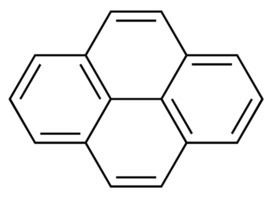Related PAHs Molar mass 202.25 g/mol Boiling point 404 °C | Formula C16H10 Density 1.27 g/cm³ | |
 | ||
Appearance colorless solid (yellow impurities are often found at trace levels in many samples) | ||
Pyrene is a polycyclic aromatic hydrocarbon (PAH) consisting of four fused benzene rings, resulting in a flat aromatic system. The chemical formula is C
16H
10. This colorless solid is the smallest peri-fused PAH (one where the rings are fused through more than one face). Pyrene forms during incomplete combustion of organic compounds.
Contents

Occurrence and reactivity

Pyrene was first isolated from coal tar, where it occurs up to 2% by weight. As a peri-fused PAH, pyrene is much more resonance-stabilized than its five-member-ring containing isomer fluoranthene. Therefore, it is produced in a wide range of combustion conditions. For example, automobiles produce about 1 μg/km. More than 20% of the carbon in the universe may be associated with PAHs, including pyrene.

Oxidation with chromate affords perinaphthenone and then naphthalene-1,4,5,8-tetracarboxylic acid. It undergoes a series of hydrogenation reactions, and it is susceptible to halogenation, Diels-Alder additions, and nitration, all with varying degrees of selectivity. Bromination occurs at one of the 3-positions.
Applications

Pyrene and its derivatives are used commercially to make dyes and dye precursors, for example pyranine and naphthalene-1,4,5,8-tetracarboxylic acid. Its derivatives are also valuable molecular probes via fluorescence spectroscopy, having a high quantum yield and lifetime (0.65 and 410 nanoseconds, respectively, in ethanol at 293 K). Its fluorescence emission spectrum is very sensitive to solvent polarity, so pyrene has been used as a probe to determine solvent environments. This is due to its excited state having a different, non-planar structure than the ground state. Certain emission bands are unaffected, but others vary in intensity due to the strength of interaction with a solvent.
Safety

Although it is not as problematic as benzopyrene, animal studies have shown pyrene is toxic to the kidneys and the liver.
Experiments in pig show that urinary 1-hydroxypyrene is a metabolite of pyrene, when given orally.
